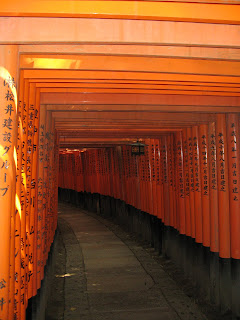 On Monday July 16th, Japan was hit by two large quakes. The first, at a magnitude of 6.6 on the Richter Scale, struck around 10:15 am in Niigata Prefecture. Hardest-hit was the town of Kashiwazaki, where at least 8 people died and 800 have been injured. The earthquake collapsed homes, buckled roads, and sparked a fire at Japan’s largest nuclear power generating facility
On Monday July 16th, Japan was hit by two large quakes. The first, at a magnitude of 6.6 on the Richter Scale, struck around 10:15 am in Niigata Prefecture. Hardest-hit was the town of Kashiwazaki, where at least 8 people died and 800 have been injured. The earthquake collapsed homes, buckled roads, and sparked a fire at Japan’s largest nuclear power generating facility .
.I was too far north to feel the first quake, but I did feel the second tremor that struck just after 11 pm. This earthquake was stronger, at 6.8, but luckily it was based out in the Sea of Japan and no direct damage has been reported as a result. While the quake didn't feel particularly powerful, it lasted over a minute. It was enough to get me out of bed, dressed, and into a door frame to wait it out while the windows and doors rattled.


Japan uses the Shindo Scale 震度 to gauge earthquake intensity which differs from the more common Richter Scale. In a country where earthquakes are said to occur once every 5 minutes, July 16th may have been just another Monday for the locals, but my routine was definitely "shaken-up"!


































 Fushimi Inari in Kyoto is the primary Shinto shrine in Japan dedicated to the spirit of Inari. Inari is the protector of cereal grains (especially rice) and is associated with wealth. As a result, many families and businesses will donate barrels of rice wine or vermilion
Fushimi Inari in Kyoto is the primary Shinto shrine in Japan dedicated to the spirit of Inari. Inari is the protector of cereal grains (especially rice) and is associated with wealth. As a result, many families and businesses will donate barrels of rice wine or vermilion  Inaria's official messengers are foxes, and so shrines are often adorned with fox sculptures. There is even a special sushi dedicated to Inari made of rice-filled sweetened tofu called Inari-zushi. Sounds nasty, but they are some tasty nums!
Inaria's official messengers are foxes, and so shrines are often adorned with fox sculptures. There is even a special sushi dedicated to Inari made of rice-filled sweetened tofu called Inari-zushi. Sounds nasty, but they are some tasty nums! 











